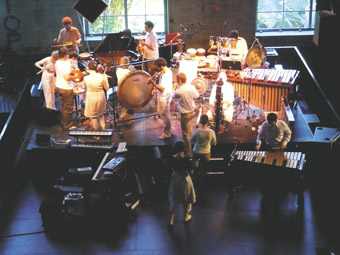composed spontaneity
greg hooper: stockhausen: a message from sirius

Queensland Conservatorium New Music Ensemble performing Ylem
photo Sharka Bosakova
Queensland Conservatorium New Music Ensemble performing Ylem
KARLHEINZ STOCKHAUSEN IS THE UBER MYTHIC CULTURE HERO. CHILDHOOD IN POVERTY, TEENS IN A NAZI YOUTH CAMP WHERE “EVERYTHING WAS ORGANISED…EVERY TOOTH, EVERY FINGERNAIL…”, HE MADE IT THROUGH WWII TO BECOME THE WUNDERKIND OF POST WAR COMPOSITION, RESHAPING MUSIC AGAIN AND AGAIN WITH RUTHLESSLY FOCUSED CONCENTRATION AND A MONASTIC WORK ETHIC. (TYPICAL STOCKHAUSEN WORKDAY: UP AT 5AM, GO TO MASS, WORK IN THE STUDIO UNTIL 7PM, GO HOME AND SKETCH OUT SOME IDEAS UNTIL 11, SLEEP, UP AT 5, GO TO MASS ETC ETC YEAR IN, YEAR OUT).
Then the story changes, he went a bit crazy-like, thought he came from outer space, descended into a megalomanic black hole and spent the next 30 years writing a grandiose opera, Licht, before delivering a final masterwork the day before he died. Make a great movie, the genius writ large then low. Some of it might even be true.
Jump to Clocked Out presenting an afternoon of Stockhausen in a free concert at the Powerhouse in Brisbane. The works go from Kontakte (1959) up to Octophonie (1990/91). Good crowd. Excellent performances. Great explanatory introductions to all the pieces from the engaging Stockhausen scholar Richard Toop.
Kontakte, for piano, percussion and electronics is a highlight. Originally designed to have performers improvising to four channel electronics, Stockhausen was unhappy with rehearsals and replaced the improvisation with specific instrumental parts to tighten up the sound play between performers and electronics. The performance by Ensemble Offspring and Jeffrey Hannam is precise and energetic. Gestures bounce sharp and fast between percussion, piano and tape. Form and theory, surface and structure, everything at every scale is smoothly coupled in a single movement of 35 minutes. (Stockhausen favoured single movements saying if he wanted to present two ideas he’d compose two pieces.)
Then Ensemble Offspring improvise with Pimmon to show Kontakte musically “in the context of the here and now.” But the problems with improvisation that Stockhausen found all those years ago reappear in the limited interplay between acoustic performers and laptop manipulations. Sharing novel and complex gestures is difficult unless the performers have many hours playing together or the genre is tightly constrained. Improvisation becomes restricted to the simpler task of exchanging and layering textures rather than developing musical gestures. This restriction drives the overall dynamics into a relatively static/ambient regime, unlike Kontakte which has enormous variety in dynamics.
A structured improvisation like Barrett’s Codex IX for the Elision ensemble sounds much more akin to Kontakte—Barrett could build in performer/performer interaction because of his many years of association with the musicians. This close connection between composer and ensemble is how Stockhausen worked throughout his career—he was always involved as performer or conductor and repeatedly rewrote works based on the experience of performance and rehearsal.
Move forward to 1972 and Ylem (played by the Queensland Conservatorium New Music Ensemble) presents Stockhausen as formalist system builder and believer in the paranormal. Ylem “best succeeds when the players establish telepathic communication with one another” (Stockhausen). The work is structured as an oscillation—out, in, then out again. Performers begin in a tight group then walk outward through the audience, return, move out again. Notes begin clustered then spread wider in pitch. Tempo starts fast, gradually slows. The effect is of time slowing down rather than notes being played differently. The process reverses, begins again. The final section has the performers moving beyond the audience and out into the space. It is as though we are observing a ritual, as though the performance is for performers rather than audience. It works beautifully and when the performers leave it is like being left alone rather than coming to the end of a piece—the music has moved over us and away.
Ylem is part of a substantial number of text and graphic scores where Stockhausen abandoned the extreme micro-control of sound structure found in Kontakte and focussed on the performer’s relationship to creating. Composing for behaviour rather than sound—or in conjunction with sound—has developed considerably over the last few years as composers write bio-behavioural models in software which then interact with live performers. Works such as those by Luke Harrald and others working with “live algorithms for music” (http://homepage.mac.com/oobop/lam/index.htm) can be genuinely musical. Fifty years ago Stockhausen had to abandon his original idea for Kontakte—performers spontaneously interacting with sounds-on-tape. Now, the computer (as person) interacts back.
Clocked Out, Stockhausen: a message from Sirius, Queensland Conservatorium New Music Ensemble; Ensemble Offspring; Pimmon; Michael Fowler; Jeffrey Hannam, Ben Marks, Tristram Williams; Brisbane Powerhouse, April 25
RealTime issue #91 June-July 2009 pg. 50






